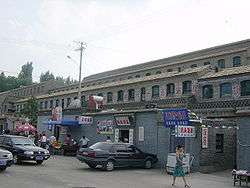Dazhai, Shanxi
| Dazhai 大寨镇 | |
|---|---|
| Town | |
 | |
 Dazhai Location in Shanxi | |
| Coordinates: 37°34′17″N 113°43′10″E / 37.57139°N 113.71944°ECoordinates: 37°34′17″N 113°43′10″E / 37.57139°N 113.71944°E | |
| Country | People's Republic of China |
| Province | Shanxi |
| Prefecture-level city | Jinzhong |
| County | Xiyang |
| Township-level divisions | 61 villages[1] |
| Elevation | 948 m (3,110 ft) |
| Time zone | China Standard (UTC+8) |
Dazhai (Chinese: 大寨; pinyin: Dàzhài; literally: "great outpost"), formerly romanized as Tachai or Ta-chai, is the name of a community of several hundred farmers in Xiyang County in eastern Shanxi province, chiefly known for Mao Zedong's directive, "Learn from Dazhai in agriculture" (农业学大寨), which set up Dazhai as the model for agricultural production throughout the China during the 1960s and ’70s, amid the Cultural Revolution.[2]
'Learn from Dazhai'
Numerous newspaper and magazine stories and books as well as films were published nationwide about how hard and diligently the villagers of Dazhai had worked to build the village into one with not only well-managed fields and bountiful crops, but engineering marvels such as amazing reservoirs and grandiose aqueducts crossing deep valleys for irrigation. They allegedly worked on their own on the principle of self-reliance, without any financial and technical support from the government.
A number of songs about Dazhai were popular for a while, the best-known perhaps being Dazhai Yakexi (yakexi is the Mandarin transliteration of the Uyghur word meaning good or great), about a Uyghur farmer telling how happy he was after he visited Dazhai. The song was adapted to a dance in which a Uyghur male sang while six ladies accompanied him with dances in the Uyghur traditional style. Both the singer and the dancers were in clothing typical of the Uyghur nationality, which the Han Chinese people found aesthetically appealing.
See also
- Learn from Daqing in industry (The industrial counterpart of Dazhai)
- Mao Zedong Thought
- Potemkin village
- shanzhai
References
- ↑ 2011年统计用区划代码和城乡划分代码:大寨镇 (in Chinese). National Bureau of Statistics of the People's Republic of China. Retrieved 2013-01-19.
- ↑ Spence's "The Search for Modern China" 2nd Edition, p.562
External links
- China-dazhai.com - a comprehensive website about Dazhai
- Zhao, "Socio-spatial transformation in Mao's China : settlement planning and dwelling architecture revisited (1950s-1970s)", Chapter 5 : Dazhai, a rural settlement, Katholieke Universiteit Leuven, 2007
- Posters of Chen Yonggui
- Soils and Sustainability: Tales from the Loess Plateau
- The Dazhai Spirit gets religion
| ||||||||||||||||||||||||||||||